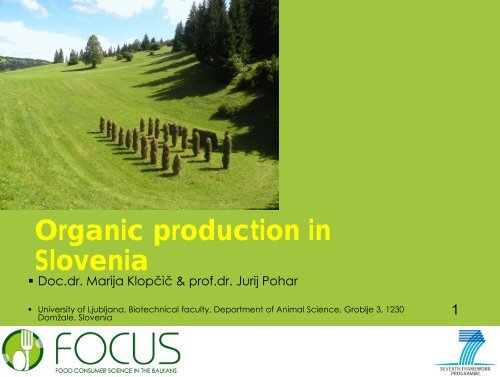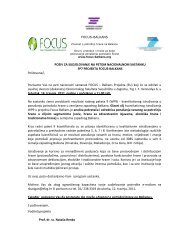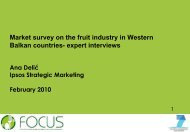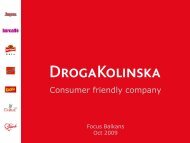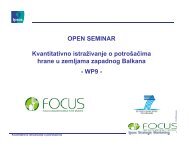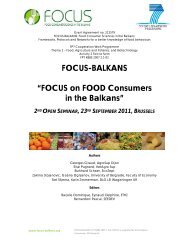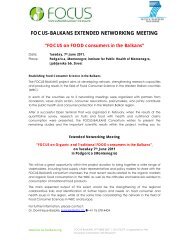Organic production in Sl i Slovenia - Focus-Balkans
Organic production in Sl i Slovenia - Focus-Balkans
Organic production in Sl i Slovenia - Focus-Balkans
You also want an ePaper? Increase the reach of your titles
YUMPU automatically turns print PDFs into web optimized ePapers that Google loves.
<strong>Organic</strong> <strong>production</strong> <strong>in</strong><br />
<strong>Sl</strong>ovenia<br />
• Doc.dr. Marija Klopčič & prof.dr. Jurij Pohar<br />
• University of Ljubljana, Biotechnical faculty, Department of Animal Science, Groblje 3, 1230<br />
Domžale, <strong>Sl</strong>ovenia<br />
1
Country overview (1)<br />
• <strong>Sl</strong>ovenia is one of the most diverse European country<br />
• Substantial share of agricultural land (74%) <strong>in</strong> <strong>Sl</strong>ovenia is<br />
designated as less favoured areas (LSA)<br />
• Given the natural conditions, <strong>Sl</strong>ovenia has high potentials for<br />
further development of organic farm<strong>in</strong>g<br />
• The demand for organic products is currently greater than the<br />
supply<br />
• The number of organic farms is <strong>in</strong>creas<strong>in</strong>g quickly, but the supply<br />
of <strong>Sl</strong>ovenian organic foodstuffs on the market does not grow<br />
proportionally to the number of organic farms<br />
• One of the reasons is the prevail<strong>in</strong>g engagement of organic farms<br />
<strong>in</strong> animal husbandry, although the greatest demand is for<br />
vegetables, fruit and non-meat processed foodstuffs (milk and<br />
milled products)<br />
2
Country overview (2)<br />
• The greatest share among the cultures under the control system is<br />
covered by grassland and <strong>in</strong>directly by animal husbandry<br />
• Animal husbandry, mostly cattle breed<strong>in</strong>g and lately also sheep<br />
breed<strong>in</strong>g, prevails <strong>in</strong> the north-western t alp<strong>in</strong>e regions and <strong>in</strong> the<br />
hilly regions<br />
• In the Northeast, Southwest (Karst coastal region) and south-east<br />
regions, there are some organic v<strong>in</strong>eyards, as well as more sheep<br />
and goat breed<strong>in</strong>g.<br />
• Orchards are spread all over the country. The most important t fruit<br />
tree is the apple, followed by pear, plum, peach and cherry trees.<br />
• A few farms <strong>in</strong> the coastal region produce olives (for olive oil), figs<br />
and khakis, but <strong>in</strong> very small amounts.<br />
• Vegetable <strong>production</strong> is ma<strong>in</strong>ly concentrated <strong>in</strong> the vic<strong>in</strong>ity of<br />
bigger cities.<br />
3
= 2.6% of all <strong>Sl</strong>ovenian farms<br />
No. of organic farms<br />
2500<br />
2000<br />
No o. of farm ms<br />
1500<br />
1000<br />
500<br />
0<br />
1998 1999 2000 2001 2002 2003 2004 2005 2006 2007 2008 2009<br />
4<br />
Year
= 6,2 % of all agricultural land <strong>in</strong> <strong>Sl</strong>ovenia<br />
<strong>Organic</strong> agricultural land<br />
35000<br />
Agr. land d, ha<br />
30000<br />
25000<br />
20000<br />
15000<br />
10000<br />
5000<br />
0<br />
1998 1999 2000 2001 2002 2003 2004 2005 2006 2007 2008 2009<br />
Year<br />
5
Imports and Exports of organic products<br />
Import<br />
• The most frequently imported products to <strong>Sl</strong>ovenia were: basic<br />
foods (gra<strong>in</strong>, pasta, oil, etc.), processed plant products, fruits,<br />
vegetables, dairy products and other<br />
Export<br />
• <strong>Sl</strong>ovenia exports only smaller amount of organic honey, meat,<br />
herbs and pumpk<strong>in</strong> seed oils. In 2005 the company Ml<strong>in</strong>otest<br />
Ajdovšč<strong>in</strong>a started to export organic bread and organic short<br />
crust pastry<br />
6
Market development<br />
• The beg<strong>in</strong>n<strong>in</strong>g of organic farm<strong>in</strong>g development <strong>in</strong> <strong>Sl</strong>ovenia lies <strong>in</strong> the<br />
1990s<br />
• First "health food shop" opened <strong>in</strong> 1989 <strong>in</strong> Ljubljana<br />
• First consumers were "eco & health freaks“; the consumers f<strong>in</strong>d the orig<strong>in</strong><br />
important (majority prefers domestic products) and often seek direct<br />
contact with farmers/producers<br />
• In the last couple of years, another group of consumers appeared:<br />
high(er)-<strong>in</strong>come trend-followers, buy<strong>in</strong>g <strong>in</strong> organic supermarket<br />
• Most of organic products are sold <strong>in</strong> largest conventional cha<strong>in</strong> Mercator<br />
(40% market share <strong>in</strong> conventional food). Spar and Tuš, are <strong>in</strong>creas<strong>in</strong>g<br />
their organic products portfolio. Some organic products are sold <strong>in</strong> DM<br />
cha<strong>in</strong>. Lidl and Hofer (Aldi) are only start<strong>in</strong>g with few products, mostly<br />
dairy and some vegetables (carrots, onions)<br />
• Purely organic shops are rare, ten at the most <strong>in</strong> whole <strong>Sl</strong>ovenia<br />
• The largest organic shop is Kalček <strong>in</strong> Ljubljana with several hundreds<br />
organic products (250 m 2 )<br />
• <strong>Organic</strong> open air markets and farm shops do not have enough supply ppy to<br />
meet all customers’ organic needs.<br />
7
<strong>Organic</strong> certification labels used<br />
In <strong>Sl</strong>ovenia next <strong>Organic</strong> certification labels are used:<br />
• BIODAR (private – national, USOFA – Union of<br />
<strong>Sl</strong>ovenian <strong>Organic</strong> Farmers' Associations)<br />
• DEMETER<br />
• State logo "ekološki"<br />
• EU logo<br />
• Others, most frequently on imported products:<br />
– EU logo<br />
– Biosiegel (German state logo),<br />
– other EU private and national logos<br />
• Certification bodies:<br />
– http://www.kon-cert.si/<br />
t – http://www.ikc-um.si/<br />
– http://www.bureauveritas.si<br />
si<br />
• To many consumers national/private logos<br />
8
Market shares – different retail types<br />
Market<br />
share<br />
Number<br />
of<br />
outlets<br />
Range width<br />
Range focus<br />
Conventional 75 – 80% 600 Approx. 2000 Basic foods*<br />
supermarkets products Processed plant products<br />
Fresh vegetables, fruits<br />
Specialised<br />
15 – 20% 20 Approx. 2500<br />
Fresh vegetables, fruits<br />
organic shops<br />
products Basic foods*<br />
Processed plant products<br />
Craft (ie.<br />
bakery,<br />
butchers…)<br />
On-l<strong>in</strong>e sales<br />
Less than<br />
1%<br />
Less than<br />
1%<br />
5 Approx. 150<br />
products<br />
n/a Approx. 1000<br />
products<br />
Bread and pastry<br />
Meat (much smaller)<br />
<strong>Organic</strong><br />
Farmers<br />
Market**<br />
Less than<br />
1%<br />
14 Approx. 150<br />
products<br />
Seasonal vegetables,<br />
fruits, cereals, juices,<br />
v<strong>in</strong>egar, oils (olive oil,<br />
pumpk<strong>in</strong> oil), herbs,<br />
spices…<br />
n/a<br />
9
<strong>Organic</strong> Food Process<strong>in</strong>g<br />
• Process<strong>in</strong>g is one of the weakest elements <strong>in</strong> <strong>Sl</strong>ovenian organic agricultural<br />
sector<br />
• Prevail<strong>in</strong>g among the processed products are pasta, flakes, oil (of pumpk<strong>in</strong><br />
seed), olive oil, v<strong>in</strong>egar, milk products, apple and grape v<strong>in</strong>egar, herbs <strong>in</strong><br />
pots, vegetable seedl<strong>in</strong>gs and others<br />
• Milk and milk <strong>production</strong> <strong>in</strong>dustry<br />
– In spite of a large amount of meadows and pastures and organic livestock<br />
it is not possible to f<strong>in</strong>d organically produced milk or meat, or milk and<br />
meat at least labelled ll as organic. The problem with milk is <strong>in</strong> the collection<br />
of milk and the <strong>in</strong>dividual dairies choice for such a <strong>production</strong> l<strong>in</strong>e.<br />
– Exception is only small dairy plant KREPKO (http://www.mlekarnakrepko.si/bio)<br />
from Logatec, which collect organic milk on <strong>Sl</strong>ovenian farms<br />
• Meat <strong>production</strong> <strong>in</strong>dustry<br />
– Some years ago the trade mark “Pohorje Beef” entered the market<br />
• Milled <strong>production</strong> <strong>in</strong>dustry<br />
– A similar problem is present <strong>in</strong> the milled <strong>production</strong> <strong>in</strong>dustry where<br />
bakeries have shown great read<strong>in</strong>ess for bak<strong>in</strong>g organic bread, but not<br />
enough raw materials (cereals or flour) are available<br />
10
<strong>Organic</strong> Food Process<strong>in</strong>g<br />
11
F<strong>in</strong>al comments<br />
• The organic market <strong>in</strong> <strong>Sl</strong>ovenia is quite young, but steadily grow<strong>in</strong>g<br />
• Most of organic products are sold <strong>in</strong> the conventional retail<br />
• The strong market leader “Mercator” sells organic products <strong>in</strong> all of its 600<br />
outlets, whereas the range of products depends on the outlet size<br />
• Specialised organic shops are still rare, at the most ten <strong>in</strong> whole <strong>Sl</strong>ovenia.<br />
There’s only one organic supermarket <strong>in</strong> Ljubljana. But a grow<strong>in</strong>g number<br />
of outlets is planned based on excellent growth forecasts<br />
• The domestic supply does not cover the demand for organic food,<br />
especially for fresh food<br />
• Future challenges lie <strong>in</strong> the <strong>in</strong>crease of demand connected with an<br />
improv<strong>in</strong>g consumer knowledge and awareness<br />
• Furthermore the domestic supply must be advanced to <strong>in</strong>crease the offer<br />
of <strong>Sl</strong>ovenian products<br />
12
Plan of Long-Term Development of<br />
organic farm<strong>in</strong>g <strong>in</strong> <strong>Sl</strong>ovenia (2005-2015<br />
• By 2015 an organic farms share <strong>in</strong> <strong>Sl</strong>ovenia of 15 % is to be reached, and a<br />
20% share of utilized agricultural area (UAA) under organic control;<br />
• By 2015 a 10 % share of organic foodstuffs of <strong>Sl</strong>ovenian orig<strong>in</strong> on the<br />
national market is to be achieved;<br />
• In the next 5 years the number of organic tourist farms is to triple;<br />
• <strong>Organic</strong> farm<strong>in</strong>g is one of the priorities <strong>in</strong> agriculture for accelerat<strong>in</strong>g the<br />
susta<strong>in</strong>able development of agriculture and establish<strong>in</strong>g the conditions for<br />
susta<strong>in</strong>able development of the country;<br />
• Provid<strong>in</strong>g better <strong>in</strong>tegration of non-governmental organisations;<br />
• Cooperation with foreign organisations and IFOAM;<br />
• Provid<strong>in</strong>g for conform, objective and multifunctional <strong>in</strong>formation actions on<br />
CAP measures to secure the overall policy image;<br />
• Establish<strong>in</strong>g close contacts with Member States and exchange of<br />
<strong>in</strong>formation;<br />
• Monitor<strong>in</strong>g the realisation of <strong>in</strong>dividual measures under the Action plan<br />
13


